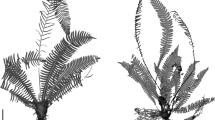Summary
The ultrastructure of the endosymbionts of several populations of whitefly (Homoptera: Aleyrodidae) was examined using transmission electron microscopy. Consistent differences in morphology and relative number of endosymbionts were observed between species and biotypes of whitefly within the Bemisia taxon.Bemisia argentifolii (=B. tabaci B biotype) individuals from Hawaii, Florida, and Arizona contained two morphological types of microorganisms housed within the mycetocyte cells of immature whiteflies. In contrast, individuals from populations ofB. tabaci A biotype from Arizona and Mexico, andB. tabaci Jatropha biotype from Puerto Rico, consistently contained three distinct morphological types of microorganisms within their mycetocytes. Organisms fromB. tabaci A and Jatropha biotypes differed from each other in the relative frequency of each type of microorganism. These observations suggest that different whitefly biotypes may have variable combinations of micro-fauna, with some possibly unique to each group, and furthers the hypothesis that variation in whitefly endosymbionts may be associated with the development of biotypes.
Similar content being viewed by others
References
Bartlett AC, Gawel NJ (1993) Determining whitefly species. Science 261: 1333–1334
Baumann P, Munson MA, Lai C-Y, Clark MA, Baumann L, Moran NA, Campbell BC (1993) Origin and properties of bacterial endosymbionts of aphids, whiteflies, and mealybugs. Am Soc Microbiol News 59: 21–24
Bellows TS, Perring TM, Gill RJ, Headrick DH (1994) Description of a species ofBemisia (Homoptera: Aleyrodidae). Ann Entomol Soc Am 87: 195–206
Bethke JA, Paine TD, Nuessley GS (1991) Comparative biology, morphometrics, and development of two populations ofBemisia tabaci (Homoptera: Aleyrodidae) on cotton and poinsettia. Ann Entomol Soc Am 84: 407–411
Bird J (1957) A whitefly-transmitted mosaic ofJatropha gossypifolia. Tech Paper Agric Exp Stat Univ Puerto Rico 22: 35
Brown JK, Frohlich DR, Rosell RC (1995) The sweetpotato or silverleaf whiteflies: biotypes ofBemisia tabaci or a species complex? Annu Rev Entomol 40: 511–534
Buchner P (1965) Endosymbiosis of animals with plant microorganisms. Interscience, New York
Byrne DN, Miller WB (1990) Carbohydrate and amino acid composition of phloem sap and honeydew produced byBemisia tabaci. J Insect Physiol 36: 433–439
Campbell BC (1989) On the role of microbial symbiotes in herbivorous insects. In: Bernays EA (ed) Insect-plant interactions. CRC Press, Boca Raton, pp 1–44
— (1993) Congruent evolution between whiteflies (Homoptera: Aleyrodidae) and their bacterial endosymbionts based on respective 18S and 16S rDNA. Curr Microbiol 26: 129–132
—, Duffus JE, Baumann P (1993) Determining whitefly species. Science 261: 1333
Clark MA, Baumann L, Munson MA, Baumann P, Campbell BC, Duffus JE, Osborne LS, Moran NA (1992) The eubacterial endosymbionts of whiteflies (Homoptera: Aleyrodidea) constitute a lineage distinct from the endosymbionts of aphids and mealybugs. Curr Microbiol 25: 119–123
Costa HS, Brown JK (1991) Variation in biological characteristics and esterase patterns among populations ofBemisia tabaci, and the association of one population with silverleaf symptom induction. Entomol Exp Appl 61: 211–219
— —, Sivasupramaniam S, Bird J (1993 a) Regional distribution, insecticide resistance, and reciprocal crosses between the A and B biotypes ofBemisia tabaci. Insect Sci Applic 14: 255–266
—, Westcot DM, Ullman DE, Johnson MW (1993 b) Ultrastructure of the endosymbionts of the whitefly,Bemisia tabaci andTrialeuroles vaporariorum. Protoplasma 176: 106–115
Data Tech (1991) Minitab reference manual. Data Tech, Valley Forge, PA
Faust RM (1992) Conference report and 5-year national research and action plan for development of management and control methodology for the sweetpotato whitefly, Houston, Texas, February 18–21, 1992. US Department of Agriculture, Agricultural Research Service, ARS-107
Gill RJ (1992) A review of the sweetpotato whitefly in southern California. Pan-Pacific Entomol 68: 144–152
Houck EJ, Griffiths GW (1980) Intracellular symbiotes of the Homoptera. Annu Rev Entomol 25: 161–187
Nardon P, Grenier AM (1991) Serial endosymbiosis theory and weevil evolution: the role of symbiosis. In: Margulis L, Fester R (eds) Symbiosis as a source of evolutionary innovation. Massachusetts Institute of Technology, Cambridge, pp 153–169
Perring TM, Cooper AD, Kazmer DJ (1992) Identification of the poinsettia strain ofBemisia tabaci (Homoptera: Aleyrodidae) on broccoli by electrophoresis. J Econ Entomol 85: 1278–1284
— —, Rodriguez RJ, Farrar CA, Bellows TS (1993) Identification of a whitefly species by genomic and behavioral studies. Science 259: 74–77
Srivastava PN (1987) Nutritional physiology. In: Minks AK, Harrewijn P (eds) Aphids, their biology, natural enemies and control. Elsevier, New York, pp 99–120
Spurr AR (1969) A low-viscosity epoxy resin embedding medium for electron microscopy. J Ultrastruct Res 26: 31–43
Ullman DE, Westcot DM, Hunter WB, Mau RF (1989) Internal anatomy and morphology ofFrankliniella occidentalis (Pergande) (Thysanoptera: Thripidae) with special reference to interactions between thrips and tomato spotted wilt virus. Int J Insect MorpholEmbryol 18: 289–310
van der Heuvel JFJM, Verbeek M, van der Wilk F (1994) Endosymbiotic bacteria associated with circulative transmission of potato leafroll virus byMyzus persicae. J Gen Virol 75: 2559–2565
Author information
Authors and Affiliations
Rights and permissions
About this article
Cite this article
Costa, H.S., Westcot, D.M., Ullman, D.E. et al. Morphological variation inBemisia endosymbionts. Protoplasma 189, 194–202 (1995). https://doi.org/10.1007/BF01280174
Received:
Accepted:
Issue Date:
DOI: https://doi.org/10.1007/BF01280174




